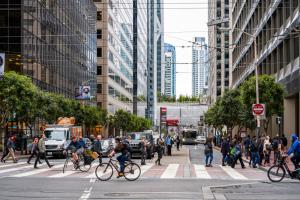ITDP Highlights Cost Savings and Climate Benefits of Transport Electrification and Compact Planning in US Cities
New research from ITDP and UC Davis finds the US could reduce public-sector expenditures with strategies that support electrification and compact planning.
The report finds that the US could feasibly reduce public-sector expenditures on urban transport at the city, state, and federal levels by a cumulative $2 trillion USD through 2050 using a combination of strategies that support electrification, compact city planning, and sustainable mobility. For individuals, the research also estimates that by 2050, such shifts could save each urban American an average of $2,000 USD every year. Furthermore, the report finds that combining these strategies will reduce carbon emissions from the national transport sector enough to meet the nation’s climate goals—but no single strategy pursued in isolation would suffice.
The report's release and findings were highlighted at an invitation-only event in January 2024 hosted by ITDP and Transportation For America (T4A) in Washington, DC. The meeting convened national transport advocates, government officials, NGOs, and researchers to discuss opportunities for decarbonizing the US transport sector based on Compact Cities Electrified and the US Department of Transportation (DOT)’s National Blueprint for Transportation Decarbonization. The discussion included USDOT representatives who spoke on federal funding initiatives for sustainable urban development and electrification, as well opportunities for more progress. ITDP, UC Davis, and T4A further made the case for the significant cost, energy, and emissions reductions possible with Electrification + Shift strategies that transform individual behaviors and system-level policies.
This new research demonstrates that the US can achieve an Electrification + Shift scenario, and it will not require any additional funding beyond the resources that the nation already expends for urban passenger transport—indeed, the Electrification + Shift scenario would require less government funding than Business as Usual, meaning that more government resources could be used for other areas of development or to lower taxes. Instead, Electrification + Shift would only require a change in policies and a reallocation of current resources. Three critical elements that must come together to achieve this scenario are identified in the report: increased vehicle efficiency, primarily through electrification; land-use reform to make trips shorter by promoting compact mixed-use cities; and modal shift, primarily facilitated by providing alternative infrastructure, but also by pricing car travel according to its actual cost.
The research offers specific, measurable goals for achieving these three elements by 2050:
Transport Electrification: Ensuring 100% of all new light-duty vehicle sales (cars and light trucks) are electric;
Land Use and Development: Promoting plans and policies that increase average urban population density to 17,000 people per square mile (similar to the city-wide average of Los Angeles, CA);
Transport Infrastructure: Building networks for public transit, cycling, and walking that reallocate resources from urban roads to entirely cease the construction or widening of urban roadways, instead adding 190,000 lane-miles of protected urban cycle lanes, 26,000 lane-miles of bus rapid transit, 2,600,000 more buses, and 18,000 more train cars, among other targets detailed in the report.
This landmark analysis provides a clear call to action for government and transport decision-makers nationwide. It also adds to a growing body of supporting evidence from peer institutions (International Transport Forum, International Council on Clean Transportation, etc.) to make the case that transport electrification and modal shift cannot occur independently; only by maximizing both strategies can the nation’s cities reduce emissions fast enough to a level approaching what is needed to combat global warming. To achieve this, the US must restructure its transport and land-use policies and investments to prioritize the sustainable movement of people rather than private vehicles.
This is the latest country-specific report from ITDP and UC Davis based on the Compact City Scenario–Electrified research released in 2021, in which the researchers modeled global changes necessary to decarbonize urban passenger transport and identified the importance of vehicle electrification combined with modal shift. While this original report was global, this series of reports examines regional contexts and data to outline scenarios in various countries. The first two focused on Egypt and India to assess similar ambitious, but feasible, scenarios for the future of each country’s urban transport sector.
“This report makes an important contribution by presenting a vision of what is possible when land use, investments, and planning decisions are aligned with ambitious climate goals,” said James Bradbury, Mitigation Program Director at the Georgetown Climate Center. “Our research has shown that investment decisions are a key piece of the low-carbon transportation puzzle. This new study shows the critical role of cities in terms of not only reducing transport-related greenhouse gas emissions but also providing cleaner air and more equitable and accessible transportation systems for urban communities all across the US.”
“Americans deserve a wider range of travel options using clean, low-carbon, and efficient vehicles, and this report’s proposed Electrification + Shift scenario is certainly not an unprecedented revolution,” said Heather Thompson, CEO of ITDP. “Rather, it is a return to the practice of building cities and neighborhoods centered around people and the environment. To do this, we will need to focus on the fundamental equation of driving less, expanding electric vehicle access, and making walking, cycling, and public transit available to everyone.”
Read the full report at ITDP.org/Publications.
Veronica Ortiz
ITDP
veronica.ortiz@itdp.org
Visit us on social media:
Facebook
Twitter
LinkedIn
YouTube
Other
Legal Disclaimer:
EIN Presswire provides this news content "as is" without warranty of any kind. We do not accept any responsibility or liability for the accuracy, content, images, videos, licenses, completeness, legality, or reliability of the information contained in this article. If you have any complaints or copyright issues related to this article, kindly contact the author above.



